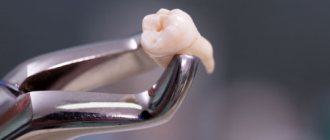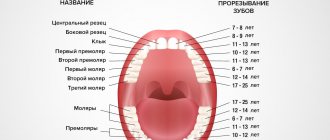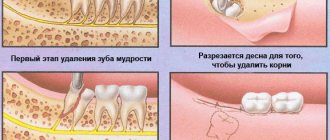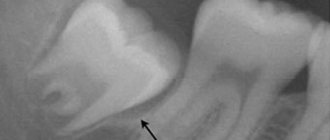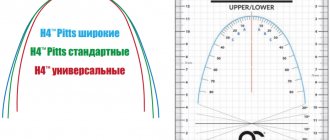Timing of teething
The wait is especially long after the removal of chewing temporary teeth, which are usually the first to suffer from caries and its complications. Often, parents frivolously insist on removing molar baby teeth, blithely declaring: permanent ones will grow in!
But the process of changing bites develops according to strict laws. Follicles (buds) of temporary and permanent teeth are located in two rows in each jaw of a newborn, going through successive stages of formation and mineralization before eruption. It is impossible to speed up these stages by any means.
The milky roots gradually dissolve, and permanent follicles are pushed out in their place by the coronal part. And only after the formation is completed, permanent teeth appear above the surface of the gum. The first to erupt is the so-called “sixth tooth” - the first molar, which parents often mistake for temporary, and therefore do not treat its carious lesions. This tooth has an important function - it determines the height of the permanent bite and the place of the other “brothers” in the dentition.
We give approximate dates for the appearance of permanent teeth to make it easier for parents to navigate the normality of the change process:
- first incisor - 6-7 years;
- second incisor - 7-8 years;
- fang - 9-11 years;
- first small root - 8-10 years;
- second small root - 11-12 years;
- first major molar - 6 years;
- second major molar - 13-14 years.
Small molars replace primary chewing teeth. If a temporary tooth was removed at the age of 6-7 years, which is not uncommon, then the child is deprived of the ability to fully chew food for as long as 5-6 years. Therefore, it is so important to promptly treat caries of milk precursors.
What causes delayed teething in children?
It must be said that there are many reasons for the delay in the appearance of baby teeth, and most often harmless factors are found. At the same time, the dentist recommends simple stimulation of teething (massage of the gums, use of special gels), and soon the long-awaited teeth take their places.
The reasons for late teething in children include:
- Hereditary factor
- Insufficient amount of useful elements (vitamin D, calcium). In this sense, infants are at risk because artificial formulas contain more minerals that promote the growth and development of teeth
- Congenital pathologies (the presence of supernumerary teeth that interfere with the eruption of the rest, tumors of various natures, regional odontodysplasia, a genetic disorder in the development of the jaws, cleft palate, cleft lip, etc.)
- Bruises, injuries, consequences of previous diseases
- Pathologies of the endocrine system (impaired hormone secretion)
- Prematurity (babies born prematurely develop more slowly than their peers)
- Past diseases and disorders during intrauterine development (lack of nutrients, poor maternal lifestyle), complicated pregnancy
- Congenital rickets
- Anemia
- Ichthyosis
- HIV infection
- Long-term chemotherapy or anticonvulsants
- Genetic abnormalities: Gardner syndrome, Down syndrome
- Delayed physical and mental development
If some of the above causes are diagnosed (for example, rickets), a cure, unfortunately, is impossible.
However, the vast majority of clinical cases are nothing more than parents’ vain worries. Most often it turns out that delayed teething is not a pathology, but a developmental feature.
Consequences of early destruction of primary teeth
After the early removal of a baby tooth, the gum in its place becomes overgrown, and the permanent one is deprived of its natural landmark. This leads to phenomena such as:
- dystopia - eruption of a permanent tooth outside the dental arch;
- retention - the occurrence of a formed tooth in the thickness of the jaw bone.
If the baby tooth does not receive treatment, and the inflammatory process spreads to its roots, then the permanent follicle located under them is damaged. In this case, the permanent one may die, and then its place in the dentition will remain empty. The absence of a tooth is confirmed by radiography.
What determines the timing of teeth appearance?
A deviation in the timing of the appearance of a baby’s first teeth from one to two months is considered normal.
Dentists believe that the appearance of teeth 1-2 months earlier or later than normal is acceptable. So, some babies have their first teeth as early as 4 months, and some don’t even have them at 11. This is dictated by the individual developmental characteristics of the baby, but it is still possible to determine the factors that influence the timing of the appearance of teeth:
- Type of feeding. As already mentioned, breastfeeding is not always better than artificial feeding. Breast milk is not as rich in nutrients as artificial formulas, so infants start teething more often
- Climatic conditions. There is an interesting pattern here: the hotter the climate, the earlier teeth appear
- Hereditary characteristics. You shouldn’t wait for a child’s first teeth at 5-6 months if the parents only got them at 9 months.
- Quality of drinking water and compliance with drinking regime
- Proper child care
So in some cases, parents' concerns are unfounded.
Problems when changing bites
Sometimes a situation arises that a child “grows a tooth under a tooth” - the permanent one has already appeared above the gum, and the temporary one is firmly held in its place. This happens when the resorption process of one or more milky roots is disrupted. This is also a reason to contact pediatric dentistry - after all, no one can say in how many days a loose baby tooth will fall out, and its “stubbornness” leads to the dystopia of a permanent one.
Dental doctors remove even such semi-loose teeth with anesthesia, so as not to cause discomfort to children. Only a specialist can decide what to do when changing the bite. Regular monitoring by the dentist during such an important period will help to avoid the formation of an abnormal relationship of the dentition, which will require further treatment by an orthodontist.
If a child’s baby tooth is loose, then you shouldn’t guess how long it will take for it to fall out; it’s better to consult a doctor without delay for qualified advice.
At the Shifa clinic, children are treated with modern equipment using the latest materials. The center has all the conditions for an accurate diagnosis of the condition of primary and permanent dentition, and this is the key to correct medical tactics. The dentists of the Shifa clinic find an approach to every child and master the most advanced methods of assistance, constantly improving their professionalism in Russia and abroad. Contact the best doctors who will help solve any dental problem!
How can you tell if teething is delayed?
Often parents make the wrong conclusions when independently diagnosing the late eruption of the first teeth.
Particularly suspicious parents, on the day when the baby celebrates 6 months from the date of birth, examine his gums and, if the first pair of teeth have not appeared, they rush to the dentist as fast as they can. In 90% of cases, the doctor examines the baby's oral cavity and sends the parents home, saying that there is no reason to worry.
A delay is a condition in which teeth grow but do not erupt. It is easy for parents to determine this: the child becomes whiny and restless, his salivation increases, his gums turn red and swell (enlarge), he tries to put all the toys and objects in his hands into his mouth, and eats poorly.
These are classic signs of teething.
It may take 2 months from the first onset of symptoms to the appearance of the first tooth. Usually, with the problem “the gums are inflamed, but the teeth are not cutting”, parents bring children aged 9 months to a year. In this case, the doctor will examine the child’s gums and prescribe a number of diagnostic measures:
- X-ray
- Blood analysis
- Urine and stool analysis
- Ultrasound of the digestive system
- Hormone testing
If health problems are detected, the dentist prescribes an individual treatment regimen. If everything is fine and the delay is not associated with various pathologies, it will most likely be recommended to review the baby’s diet, increase the intake of vitamin D, massage the gums - in other words, promote teething in the child.
Some facts about teething in humans
Teething is a dynamic and complex physiological process that continues for several years. At this time, the maturation of tooth germs or follicles occurs and their migration inside the jaw until they finally erupt into the oral cavity and take their proper functional position in the dentition.
Teething is often quite painful
Teething involves a gradual transition from one bite to another: a temporary or milk bite is replaced by a permanent one. This process is very closely related to the child’s bone development, in particular, to the correct growth of the skull bones. In this case, there is a parallel formation of bone structures, soft tissues surrounding the tooth, and resorption of the roots of baby teeth to make room for permanent teeth. The rate of eruption depends on the timing of completion of the formation of dental follicles on both sides of the dental arch.
Child with a gum massager toy
The first stages of dental development begin in the embryonic stage, this process ends with the eruption of third molars (wisdom teeth) at the age of 20 years. The direct mechanism of eruption has not yet been fully studied; scientists have put forward some guesses, but none of them have been proven in practice.
The structure of a wisdom tooth is no different from other teeth, or more precisely, from other molars, that is, teeth that perform a chewing function.
What types of delayed eruption are there?
Most often, the delay in the appearance of teeth occurs in the mixed dentition and does not manifest itself clinically. A departure from the average time for the eruption of baby teeth by more than six months is considered a delay. Permanent teeth should erupt no later than one year from the average date.
Scheme of eruption of molars in children
There are two distinct subtypes of late teething.
- In what order do babies' teeth grow?
- Associated late maturation of the dental follicle . In this case, coordination between the development of the tooth and its appearance in the oral cavity is observed, but both processes occur more slowly than usual.
- Late eruption . In such a situation, the tooth forms and matures fully, its root grows, but a physical obstacle prevents the tooth from reaching the surface. Thus, fully formed teeth become encased in bone, or impacted. They can be completely hidden by the gum or come out from under it partially - with one or two bumps.
Classification of teething diseases according to A. G. Shargorodsky
However, before talking about delayed eruption, you need to make sure that the tooth germ is even present in the bone. To do this, it is necessary to take a panoramic photograph of the teeth, which will distinguish partial primary adentia (the dental follicle was not initially embedded in the jaw) from delayed tooth formation.
Panoramic photo of teeth
